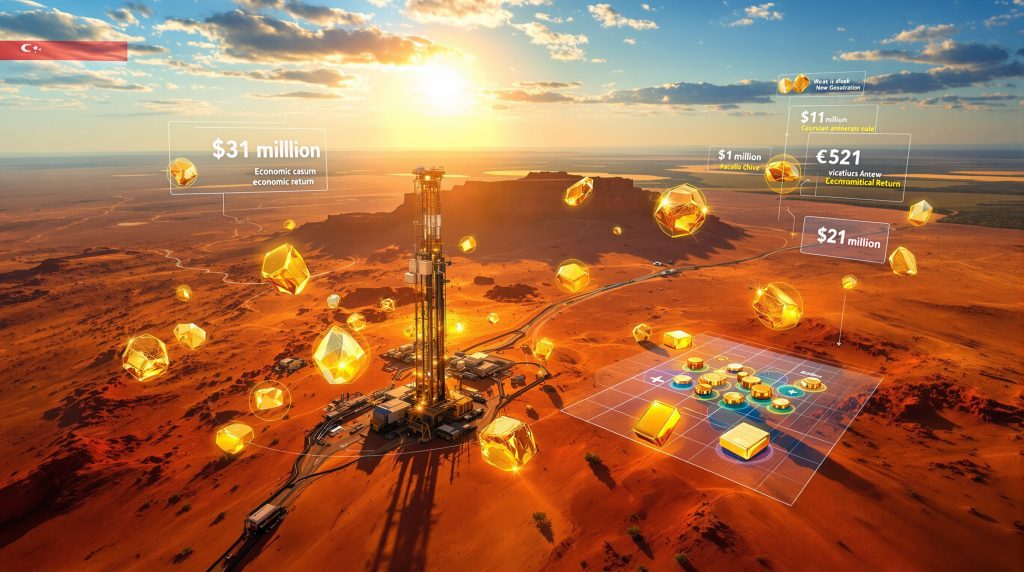Western Australia's Exploration Incentive Scheme: Fueling Mineral Discovery Success
The Exploration Incentive Scheme (EIS) stands as a cornerstone of Western Australia's resource development strategy, strategically designed to stimulate mineral exploration and discovery across the state's vast and resource-rich terrain. This innovative government program has transformed the exploration incentive scheme in Western Australia since its inception in 2009, delivering substantial economic returns while expanding the state's mineral resource inventory.
How Does the Exploration Incentive Scheme Work?
The Exploration Incentive Scheme operates through a co-funding model that effectively shares financial risk between the government and exploration companies. By covering up to 50% of direct drilling costs, the program enables companies to pursue innovative exploration projects that might otherwise remain unexplored due to capital constraints or perceived risk levels.
This co-funding approach is particularly valuable for junior exploration companies and smaller operators who often face significant financial hurdles when attempting to test new geological concepts or explore underexplored regions.
The scheme strategically prioritizes greenfield exploration—areas with limited previous drilling or mineral development—to maximize the potential for discovering entirely new mineral systems. This focus on underexplored territories helps extend Western Australia's resource horizon beyond established mining districts, potentially unlocking entire new mineral provinces.
Applications undergo rigorous technical assessment, with projects evaluated based on geological merit, innovative exploration methodologies, and potential economic impact. This competitive selection process ensures funding flows to projects with the strongest scientific basis and discovery potential.
Western Australia's Mines and Petroleum Minister David Michael has emphasized that the EIS plays a critical role in "reducing the financial risks of exploration" and "unlocking the next generation of mineral projects," demonstrating the government's strategic approach to resource development.
What Makes the EIS a Critical Economic Driver?
Economic Impact and Return on Investment
The EIS delivers exceptional economic returns for Western Australia through its multiplier effect on exploration investment. While precise economic multipliers require careful analysis, the program's impact extends far beyond the initial government expenditure through:
- Creation of direct exploration jobs in regional communities
- Stimulation of local service industries supporting exploration activities
- Development of new mines generating long-term employment
- Increased tax revenue from successful mining operations
- Attraction of international investment capital to Western Australia
The most recent round of funding (Round 32) allocated A$6.6 million across 39 projects, representing a significant investment in the state's mineral future. This continued investment demonstrates the Western Australian government's confidence in the program's economic benefits and strategic importance to the WA resources impact.
Regional Development Benefits
The EIS delivers substantial benefits to regional Western Australia beyond purely economic returns:
- Creation of skilled employment opportunities in remote communities
- Development of regional infrastructure supporting exploration activities
- Support for local businesses providing services to exploration companies
- Training and employment pathways for Indigenous communities
- Knowledge transfer to regional workforces
Minister David Michael has highlighted how the EIS is "opening the door to new mines, regional jobs and long-term economic growth," underscoring its role in supporting rural and regional development across Western Australia.
What Minerals Are Being Targeted in Recent Funding Rounds?
Gold Dominates Recent Applications
Analysis of the latest EIS funding round (Round 32) reveals gold's continued dominance in Western Australia's exploration landscape. Gold targets accounted for 64% of successful applications, either as a standalone target or in combination with other minerals.
This gold-focused exploration pattern reflects several factors:
- Western Australia's globally significant gold endowment and geological potential
- The region's well-established gold processing infrastructure reducing development barriers
- Strong gold price performance incentivizing exploration investment
- Relatively lower technical barriers to gold drilling insights compared to some other minerals
- Established metallurgical processes reducing development risk
The concentration of gold-focused projects demonstrates both the enduring importance of this precious metal to Western Australia's mining sector and the continued geological potential for new gold discoveries despite the state's long mining history.
Critical Minerals Focus
While gold leads current exploration efforts, the EIS has strategically expanded its focus to support critical minerals transition exploration aligning with global energy transition needs. The Cook government has emphasized positioning Western Australia as a global supplier of minerals essential for clean energy technologies and decarbonization.
This strategic pivot encompasses:
- Increased support for copper exploration, essential for electrification infrastructure
- Funding for battery metals including lithium, nickel, and cobalt projects
- Exploration targeting rare earth elements needed for permanent magnets
- Projects seeking technology metals critical to renewable energy systems
Minister Michael noted the "growing momentum across the sector to support the world's clean energy future," reflecting how the EIS is adapting to changing global mineral demand patterns driven by decarbonization and technological advancement.
What Recent Success Stories Highlight the EIS Impact?
Copper Discoveries Demonstrate Program Value
Recent EIS-funded drilling programs have yielded significant copper discoveries, demonstrating the program's effectiveness in generating new resource opportunities:
| Company | Project | EIS Round | Discovery Highlights |
|---|---|---|---|
| Lord Resources | Ilgarari | Round 31 | Primary copper mineralization intersected through co-funded drilling |
| Redstone Resources | West Musgrave (Chatsworth) | Round 29 | 10-meter zone of continuous copper mineralization in co-funded drillhole |
These discoveries illustrate the tangible outcomes of the co-funding approach. By reducing financial barriers to exploration, the EIS enables companies to test geological concepts and targets that might otherwise remain undrilled, potentially leading to significant new mineral deposits that will support Western Australia's future mining industry.
Geophysical Program Success
Beyond drilling support, the EIS has expanded to include co-funded geophysical surveys, with early success already emerging from these initiatives:
- Sipa Resources reported enhanced prospectivity at its Barbwire Terrace lead/zinc/silver project following a co-funded gravity survey under the inaugural Co-funded Geophysics Program (Venture 1)
- Geophysical surveys have proven particularly valuable for identifying deeper targets that might be missed by conventional exploration approaches
- Advanced geophysical methods help companies refine target selection before committing to expensive drilling programs
This expansion into geophysical support demonstrates the program's evolution to address diverse exploration needs across different geological settings and exploration stages.
How Is the EIS Structured to Maximize Exploration Success?
Multiple Funding Streams
The EIS has evolved to incorporate multiple specialized funding streams designed to address different exploration challenges and methods:
-
Co-funded Drilling Program: The cornerstone initiative providing up to 50% of direct drilling costs for innovative exploration projects.
-
Co-funded Geophysics Program: Supporting innovative geophysical surveys to identify new targets and refine exploration models without the expense of drilling.
-
Co-funded Energy Analysis: Specialized funding for energy resource assessment, broadening the program's scope beyond mineral resources.
This multi-faceted approach ensures the scheme addresses diverse exploration needs across Western Australia's varied geological terrains and resource types, maximizing the program's reach and effectiveness.
Application and Selection Process
The EIS employs a competitive application process to ensure funding supports the most promising projects:
- Regular application rounds (typically twice yearly) provide consistent opportunities for companies to access support
- Merit-based assessment by technical experts ensures geological soundness
- Selection criteria favor innovative approaches and underexplored areas
- Public data release requirements ensure information becomes part of the state's geological knowledge base
Successful applicants from Round 32 will undertake resource exploration drilling before November 2026, with results contributing to Western Australia's collective geological understanding regardless of discovery outcomes.
What's Next for the Exploration Incentive Scheme?
Upcoming Funding Opportunities
The EIS maintains a regular schedule of funding rounds to provide ongoing support for exploration. Upcoming opportunities include:
- Co-funded drilling round 33
- Co-funded geophysics venture 3
- Co-funded energy analysis series 9
Applications for these programs will open on February 2, 2026, continuing the cycle of exploration support and maintaining momentum in Western Australia's mineral discovery pipeline.
Strategic Direction
Moving forward, the EIS is increasingly aligned with Western Australia's strategic minerals priorities, particularly:
- Supporting exploration for minerals essential to the clean energy transition
- Encouraging innovative technologies that can identify deeply buried deposits
- Promoting sustainable exploration practices with minimal environmental impact
- Enhancing geological data accessibility to maximize the value of previous exploration
This strategic alignment ensures the program remains relevant and responsive to evolving global mineral demands while supporting Western Australia's position as a leading mineral supplier.
How Does the EIS Compare to Other Exploration Incentives?
Distinctive Features
Western Australia's EIS stands out among global exploration incentive programs through several distinctive features:
- Direct co-funding model rather than relying solely on tax incentives
- Focus on greenfield areas with higher discovery potential but increased risk
- Public data release requirements that build collective geological knowledge
- Integration with broader geological survey initiatives
These elements have contributed to the scheme's success in stimulating exploration activity and generating discoveries that might not have occurred under traditional exploration funding models.
Measurable Outcomes
The program's effectiveness is reflected in tangible outcomes:
- A$6.6 million allocated in the latest round (Round 32) supporting 39 projects across Western Australia
- Consistent industry participation across multiple funding rounds
- Documented discoveries directly attributable to EIS funding
- Sustained government commitment since the program's 2009 inception
These measurable results demonstrate the program's value to Western Australia's resource sector and broader economy.
What Makes the EIS Critical for Western Australia's Future?
Supporting the Energy Transition
The EIS plays a vital role in positioning Western Australia as a key supplier of minerals essential for global decarbonization:
- Facilitating discovery of battery minerals needed for energy storage technologies
- Supporting exploration for rare earths used in permanent magnets for wind turbines and electric vehicles
- Enabling copper discoveries critical for electrification infrastructure
- Identifying resources needed for emerging green technologies
As Minister Michael noted, these discoveries will help "power the world and deliver benefits for generations of Western Australians," linking the program directly to global sustainability goals.
Sustaining Western Australia's Mining Leadership
By continually replenishing the resource pipeline, the EIS helps maintain Western Australia's position as a global mining leader:
- Ensuring new discoveries replace depleting reserves at existing operations
- Attracting international investment to the state's exploration sector
- Building the knowledge base needed for future discoveries in increasingly challenging geological settings
- Supporting the mining service sector that underpins the state's economy
This forward-looking approach helps ensure Western Australia's mining industry remains vibrant and competitive in an increasingly complex global resource landscape.
FAQ: Western Australia's Exploration Incentive Scheme
Who can apply for EIS funding?
Companies registered for GST in Australia with appropriate exploration licenses can apply for EIS co-funding. Applications are assessed on technical merit and innovation.
What costs does the EIS cover?
The scheme covers up to 50% of direct drilling costs, including mobilization, drilling operations, and essential sample analysis. Indirect costs and overhead expenses are not eligible.
How often are funding rounds opened?
Typically twice yearly, with applications for the next rounds opening on February 2, 2026, according to the latest government announcement.
What happens to the data from EIS-funded projects?
Recipients must submit comprehensive reports and data, which become publicly available after a confidentiality period. This requirement builds Western Australia's collective geological knowledge base and benefits future exploration.
How long has the EIS been operating?
The scheme was launched in 2009 and has maintained consistent operation, with ongoing government support through multiple political administrations, demonstrating its value to Western Australia.
Further Exploration
Readers interested in learning more about Western Australia's mineral exploration importance can explore additional resources available from the Geological Survey of Western Australia, which offers comprehensive information on the state's mining and exploration sector.
Disclaimer: While this article presents information about the exploration incentive scheme in Western Australia based on publicly available data, exploration outcomes involve inherent uncertainty. Past discoveries do not guarantee future exploration success. Companies mentioned are for illustrative purposes only, and this article does not constitute investment advice.
Looking for an Edge in ASX Mining Discoveries?
Don't miss out on the next major mineral find! Discovery Alert's proprietary Discovery IQ model delivers instant notifications on significant ASX mineral discoveries, turning complex data into actionable investment insights before the broader market reacts. Explore historic examples of exceptional returns on the dedicated discoveries page and start your 30-day free trial today.




